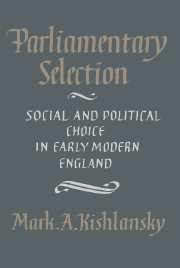5 - The Transition
from PART II - ELECTIONS AND POLITICAL CHOICE
Published online by Cambridge University Press: 22 September 2009
Summary
History prefers the incipient to the vestigial. Any study of the growth of institutions and ideas quite naturally stresses the thriving members of the social organism. The atrophied lose their interest along with their function. The time-lapse photography that historians practice magnifies change and compresses its pace; and photographic technique possesses many other advantages. By freezing the frames appropriately it throws into relief transformations which might otherwise be imperceptible. By isolating shifts in attitudes and practices it examines them more precisely and better predicts their impact upon the larger system. In short, it gives innovation its proper shape and importance.
Yet the drawbacks can be equally potent. Anachronism and inevitability are constant dangers. In analysis the result defines the intermediate points of interest; in reality the process unfolds in the opposite direction. Thus historians endow participants with foreknowledge and emphasize those who tread along preordained paths. All too frequently the formative period is given characteristics that only subsequently appear. The result becomes the only possible result. The durability of past practices is minimized and their impact on the emergence of new ones undervalued. The contrast between before and after attenuates the periods of coexistence – periods which are fundamental in shaping both change and a society's reaction to it.
The problem admits of no easy solution. Blurring the lines of change eases the dilemma of the society that has experienced it.
- Type
- Chapter
- Information
- Parliamentary SelectionSocial and Political Choice in Early Modern England, pp. 105 - 135Publisher: Cambridge University PressPrint publication year: 1986

